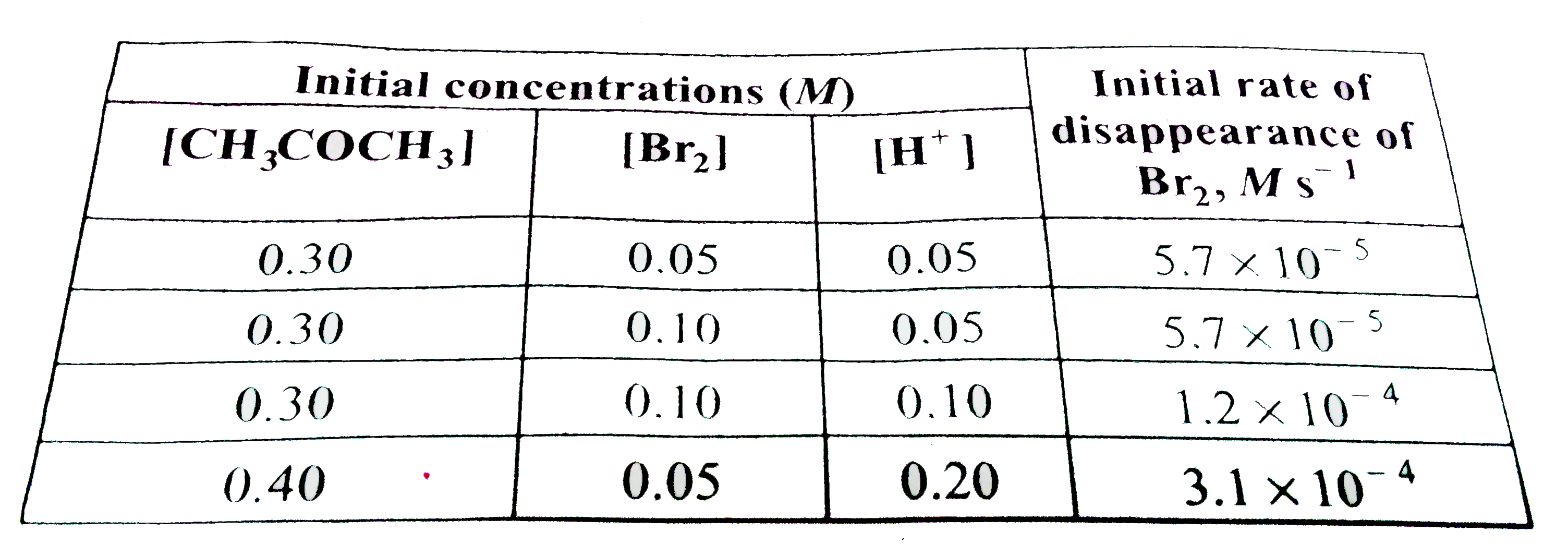The bromination of acetone that occurs in acid solution is represented by this equation.
CH3COCH3(aq)+Br2(aq)→
CH3COCH2Br(aq)+H+(aq)+Br(aq)
These kinetic data were obtained for given reaction concentrations.
Initial concentration, M
[CH2COCH3][Br2][H+](Initail rate) (disappearance of Br2)0.300.050.055.7×10−50.300.100.055.7×10−50.300.100.101.2×10−40.400.50.203.1×10−4
Rate =k[CH3COCH3][Br2][H+]2
Rate =k[CH3COCH3][Br2][H+]
Rate =k[CH3COCH3][H+]
Rate =k[CH=COCH3][Br2]
The correct Answer is:C
According to the given data, when concentration of Br2 is doubled, the initial rate of disappearance of Br2 remains unaffected. So order of reaction with respect to Br2 is zero. The rate law for the reaction will be :
k[CH3COCH3][H+]
Topper's Solved these Questions
- NEETBOOK - NEET PREVIOUS YEAR (YEARWISE + CHAPTERWISE)CHAPTER - NEETEXERCISE - QUESTION
95 Videos
- NEETBOOK - NEET PREVIOUS YEAR (YEARWISE + CHAPTERWISE)CHAPTER - NEETEXERCISE - MCQ
95 Videos
- NEETBOOK - NEET PREVIOUS YEAR (YEARWISE + CHAPTERWISE)CHAPTER - NEETEXERCISE - MCQ
95 Videos
- MOTION IN TWO AND THREE DIMENSIONBOOK - NEET PREVIOUS YEAR (YEARWISE + CHAPTERWISE)CHAPTER - MOTION IN TWO AND THREE DIMENSIONEXERCISE - All Questions
47 Videos
- NEET 2020BOOK - NEET PREVIOUS YEAR (YEARWISE + CHAPTERWISE)CHAPTER - NEET 2020EXERCISE - All Questions
45 Videos
Similar Questions
The bromination of acetone that occurs in acid solution is represented by
CH3COCH3(aq.)+Br2(aq.)→CH3COCH2Br(aq.)+H+(aq.)+Br−(aq.)
These kinetic data were obtained for given reaction concentration
Initial concentration
Initial concentrationInitial rate ofdisappearance[CH3COCH3][Br2][H+]of Br20.300.050.055.0×10−50.300.100.55.0×10−50.300.100.101.0×10−40.900.050.103.0×10−4
Based on these data, order of reaction will be -
View SolutionThe bromination of acetone that occurs in acid solution is represented by this equation
CH3COCH3(aq)+Br2(aq)→CH3COCH2Br(aq)+H+(aq)+Br−(aq)
These kinetic data were obtained for given reaction concentrations .Initial concentrations , M
[CH3COCH3][Br2][H+]0.300.050.050.300.100.050.300.100.100.400.050.20
Initial rate , disappearance of Br2,Ms−1
View Solution
Knowledge Check
The bromination of acetone that occurs in acid solution is represented by this equation.
CH3COCH3(aq)+Br2(aq)→
CH3COCH2Br(aq)+H+(aq)+Br(aq)
These kinetic data were obtained for given reaction concentrations.
Initial concentration, M
[CH2COCH3][Br2][H+](Initail rate) (disappearance of Br2)0.300.050.051.5×10−50.300.100.055.7×10−50.300.100.101.2×10−40.400.50.203.1×10−4Arate =k[CH3COCH3][Br2]Brate =k[CH3COCH3][Br2][H+]2Crate =k[CH3COCH3][Br2][H+]Drate =k[CH3COCH3][H+]The bromination of acetone that occurs in acid solution is represented by
CH3COCH3(aq.)+Br2(aq.)→CH3COCH2Br(aq.)+H+(aq.)+Br−(aq.)
These kinetic data were obtained for given reaction concentrations :

Based on these data, rate equations is :ARate=k[CH3COCH3][Br2][H+]2BRate=k[CH3COCH3][Br2][H+]CRate=k[CH3COCH3[H+]DRate=k[CH3COCH3[Br2]The bromination of acetone that occurs in acid solution is represented by this equation.
CH3COCH3(aq)+Br2(aq)→CH3COCH2Br(aq)+H+(aq)+Br−(aq)
These kinetic data were obtained for given reaction concentrations.
[CH3COCH3][Br2][H+]rate of disappearance of Br2,(Ms−1) 0.300.050.05 5.7×10−5 0.300.100.05 5.7×10−5 0.300.100.10 1.2×10−4 0.400.050.20 3.1×10−4
Based on these data, the rate equation isARate=k[CH3COCH3][Br2][H+]2BRate=k[CH3COCH3][Br2][H+]CRate=k[CH3COCH3][H+]DRate=k[CH3COCH3][Br2]
The bromination of acetone that occurs in acid solution is represented by
CH3COCH3(aq.)+Br2(aq.)→CH3COCH2Br(aq.)+H+(aq.)+Br−(aq.)
These kinetic data were obtained for given reaction concentrations :

Based on these data, rate equations is :
View SolutionThe bromination of acetone which occurs in acid solution is represented by the equation:
CH3COCH3(aq)+Br2(aq)→CH3COCH2Br(aq)+H+(aq)+Br−1(aq)
The following kinetic data was obtained for the given reaction concentration:

Initial rates of disappearance of of Br2(Ms−1
5.7×10−5,5.7×10−5
1.2×10−4,3.1×10−4
Based on these data, the rate equation is:
View SolutionConisder the reaction represented by the equation:
CH3Cl(g)+H2O(g)→CH3OH(g)+HCl(g)
These kinetics data were obtained for the given reaction concentrations:
Initial conc (M)Initial rate of disappearance[CH3Cl][H2O]of CH3Cl(Ms−1)0.20.210.40.220.40.48
Order with respect to [CH3Cl] will be
View SolutionConisder the reaction represented by the equation:
CH3Cl(g)+H2O(g)→CH3OH(g)+HCl(g)
These kinetics data were obtained for the given reaction concentrations:
Initial conc (M)Initial rate of disappearance[CH3Cl][H2O]of CH3Cl(Ms−1)0.20.210.40.220.40.48
The rate law for the reaction will be
View SolutionConisder the reaction represented by the equation:
CH3Cl(g)+H2O(g)→CH3OH(g)+HCl(g)
These kinetics data were obtained for the given reaction concentrations:
Initial conc (M)Initial rate of disappearance[CH3Cl][H2O]of CH3Cl(Ms−1)0.20.210.40.220.40.48
Unit of rate constant will be
View Solution
